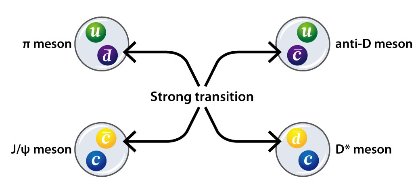May 12, 2017 Research Highlight Physics / Astronomy
The particle physics mixer
The process by which an exotic particle is briefly created in particle colliders has been uncovered
 Figure 1: The tetraquark candidate Zc(3900) observed in experiments turned out to be a transition between two meson states that involves the rearrangement of quarks and anti-quarks. © 2017 RIKEN Nishina Center for Accelerator-Based Science
Figure 1: The tetraquark candidate Zc(3900) observed in experiments turned out to be a transition between two meson states that involves the rearrangement of quarks and anti-quarks. © 2017 RIKEN Nishina Center for Accelerator-Based Science
An exotic particle seen only when charged particles are smashed together in very high-speed collisions has been theoretically studied by RIKEN researchers1. Their findings will help build a more complete picture of how the fundamental building blocks of matter combine to form the world around us.
At its most basic level, matter is made up of particles known as quarks. These ephemeral particles are not stable on their own—they exist only when two or three of them combine to form larger particles. Everything we see around us is made up of trios of quarks (in the form of neutrons and protons, which make up the nuclei of atoms) and electrons, which are fundamental particles like quarks.
But four-quark particles, tetraquarks, and even five-quark particles, pentaquarks, may exist. While these exotic particles are not likely to be found under normal conditions, they might be fleetingly created when more stable particles are collided at velocities approaching the speed of light, as happens in particle accelerators.
In 2013, two groups, one at the Beijing Electron–Positron Collider II in China and the other at High Energy Accelerator Research Organization in Japan, independently identified a particle that may well be a tetraquark when then they collided beams of electrons and their antiparticles, positrons.
Yoichi Ikeda at the RIKEN Nishina Center for Accelerator-Based Science and his colleagues have now theoretically studied this tetraquark candidate, referred to as Zc(3900), in an attempt to discover how is it formed.
There are six types, or ‘flavors’, of quarks—up, down, strange, charm, bottom and top—and each one has an antiparticle version. “If it exists, Zc(3900) will consist of a charm quark, an anti-charm quark, an up quark and an anti-down quark,” says Ikeda.
The team used a powerful theoretical framework known as lattice quantum chromodynamics to investigate the interactions between these four quarks. Their calculations revealed that a transition occurs between two pairs of quarks, which are called mesons (Fig. 1).
“Based on our calculations, we concluded that the tetraquark candidate Zc(3900) is not a new state,” says Ikeda. “Rather, it is the transition between two pairs of mesons.”
“Our results demonstrate that it is possible to determine the nature of exotic particles from first-principles calculations using lattice quantum chromodynamics,” he adds.
The team now intends to apply the calculation method to two other potential new particles—another tetraquark candidate, X (3872), and the pentaquark candidate Pc (4450).
Related contents
- Narrowing the gap between theory and experiment
- A new flavor of superconductor
- High-energy particle collisions reveal the unexpected
References
- 1. Ikeda, Y., Aoki, S., Doi, T., Gongyo, S., Hatsuda, T., Inoue, T., Iritani, T., Ishii, N., Murano, K. & Sasaki, K. Fate of the tetraquark candidate Zc (3900) from lattice QCD. Physical Review Letters 117, 242001 (2016). doi: 10.1103/PhysRevLett.117.242001
